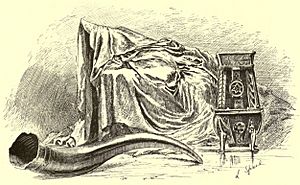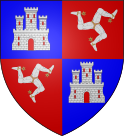Roderick Macleod of Macleod facts for kids
Quick facts for kids
Rory Mor MacLeod of MacLeod
|
|
|---|---|

Relics of Rory Mor including his drinking horn
|
|
| Born | 1559, 1562 or 1573 |
| Died | 1626 |
| Title | The 15th Chief of Clan MacLeod |
| Predecessor | John (nephew) |
| Successor | John MacLeod (son) |
| Children |
|
Sir Rory MacLeod (born around 1559–1573, died 1626) was a very important leader of the Clan MacLeod. He was the 15th Chief of his clan. People often called him Roderick MacLeod or by his Scottish Gaelic name, Ruairidh Mór, which means 'Rory the Great'. He was known as one of the most famous and powerful chiefs of the MacLeod clan.
Contents
The Life of Rory Mor
Roderick MacLeod, also known as "Rory Mor," was born in Dunvegan, Scotland. He became the 15th chief of the Clan MacLeod in 1595. This happened after his young nephew passed away. Rory Mor was the second son of Norman MacLeod, who was the 12th chief of the clan.
Around 1598, Rory Mor married Elizabeth MacDonald. She was the daughter of the 8th Chief of Clan MacDonald of Glengarry. Rory and Elizabeth had many children together. They had 11 children in total: 5 sons and 6 daughters.
Some of their children included:
- Margaret MacLeod, who married Hector Mor Maclean, the 16th Chief of Clan Maclean.
- Mary MacLeod, who married Sir Lachlan Maclean, 1st Baronet and 17th Chief of Clan Maclean.
- Ian Mor Macleod, who became the 16th Chief after his father. He married Sybella Mackenzie.
- Sir Norman MacLeod, who became the 1st Lord of Berneray. He was also the 4th Chief of Waternish. King James VI of Scotland made him a knight in 1613.
His Later Years and Death
Sir Roderick MacLeod passed away in 1626. He was buried at Fortrose Abbey, which is just north of Inverness, Scotland.
After his death, his oldest son, John "Iain/Ian Mor Macleod," became the 16th chief of the Clan MacLeod.
Famous Battles and Challenges
Sir Roderick was a brave leader. He once traveled to Ireland with 500 of his clan members. They went to help Hugh Roe O'Donnell in his fight against the English.
After returning from Ireland, Rory Mor got into a big disagreement with his brother-in-law, Donald Gorm Og MacDonald. Donald was the chief of the strong Clan MacDonald of Sleat. Even though their clans had fought together in Ireland, they became enemies. This happened because MacDonald rejected his wife, who was Rory Mor's sister. He then became very unfriendly towards the MacLeods.
After a year of fighting, the two clans finally met in the Battle of Coire Na Creiche. In this battle, the MacLeods were defeated. This was the last big clan battle that took place on the Isle of Skye.
In December 1597, a law was passed in Scotland. It said that all chiefs and landowners in the Highlands and Western Isles had to show proof of their land ownership. If they didn't, they could lose their lands. Sir Roderick did not follow this law. Because of this, his lands were given to some gentlemen from Fife. These men wanted to start new settlements there.
However, Rory Mor managed to deal with these attempts. He was successful in getting a special pardon from King James VI of Scotland. This pardon, dated May 4, 1610, allowed him to keep his lands in Harris, Dunvegan, and Glenelg.
Rory Mor's Special Horn
One of the most prized items of the Clan MacLeod is Sir Rory Mor's Horn. You can find it at Dunvegan Castle on the Isle of Skye in Scotland.
Sir Rory Mor's Horn is a special drinking horn. It is made from an ox's horn and has a silver tip. The rim around the top of the horn is thick. On this rim, there are seven round medallions. Three of these medallions show pictures of animals. Three others have interesting patterns. The seventh medallion, which connects the others, has both a pattern and an animal. Some experts believe this horn is very old, possibly from the 10th century.


